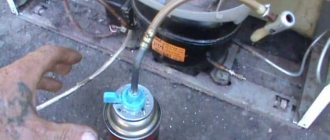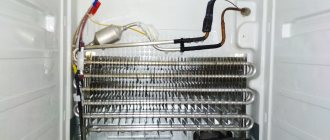Transporting in an incorrect position
The refrigerator is best transported vertically. On the side or back wall - as a last resort. The same applies to lifting and delivery to the floor. If he was brought in lying down, it’s the same as being brought in in that position.
The fact is that the refrigerator compressor is located at the bottom. There is a compressor small in its crankcase. When transported lying down or on its side, it ends up in the freon tubes. From there the oil flows into the evaporator or condenser. Although he shouldn't be there. Regarding transportation methods, we recommend reading the article about the correct transportation of the refrigerator in different positions.
Advice
If you have to transport or carry the refrigerator on its side, read the instructions. Manufacturers indicate on which side it should be transported - left or right.
Improperly carrying the refrigerator.
Rules for transporting equipment
For some models, the tilt angle should not exceed 40 degrees. Due to the height of the unit, which exceeds the capacity of the body, it is necessary to transport the refrigerator on its side, violating transportation rules.
Transportation recommendations:
- It is better that the object is in a vertical position.
- It is necessary to tilt it 40 degrees, if this is stated in the instructions.
- When transportation is only possible in a horizontal position, special measures must be taken to prevent damage.
- If the delivery service insists on checking the functionality of the refrigerator in front of them, you should refuse the purchase. Most likely, the product is faulty and was damaged during transportation. Unscrupulous movers try to shift the blame onto the client.
After delivery, the equipment cannot be turned on for a certain period. To clarify the interval, you need to read the instructions, ask the movers, and read the recommendations of specialists.
Shaking during transportation
A lot of shaking during transportation is another reason why you can’t immediately turn on the refrigerator. Especially in summer, when the oil in the compressor becomes less viscous due to high temperature. During vibration, it can flow into the pipes leading to the evaporator or condenser.
The likelihood of this happening is low. But if you transport equipment along a country road, and even in the summer, when the oil heats up and becomes too liquid... That is why the refrigerator must be left to rest, even if it was transported according to the rules.
What can happen
What happens if you turn on the refrigerator immediately after transportation? There are several possible consequences, namely:
- The refrigerator will not cool well for several hours to several days;
- The compressor will work with increased load until it moves the oil through the system;
- The refrigerator will not turn on due to the compressor being turned off by the security system;
- The compressor may jam due to lack of oil in it;
- The compressor may burn out due to increased load (especially in winter);
- The oil may decompose due to the high temperature in the compressor.
In any case, it is better to wait a while and not take risks. If the refrigerator does not cool well at first, it’s not so bad. But if the compressor seizes, repairing it will be expensive. In some cases it will cost up to 30% of the price of the refrigerator
After how many hours do you turn on the refrigerator?
There is no exact recommendation for how long you can turn on the refrigerator after transportation or delivery. It depends on the time of year and the position in which the refrigerator was transported.
When transporting lying down, the power of the refrigerator plays a role. The larger it is, the greater the volume of oil in the compressor. Accordingly, more of it will leak into the condenser or evaporator. After this, it will take more time for it to flow into the compressor.
Here we provide general recommendations. For example, a low-power refrigerator needs to stand for 2 hours. And high power – 3 hours. Nothing bad will happen if a low-power refrigerator sits for an hour longer.
In summer
- When transported in an upright position, you can turn on the refrigerator after 4 hours;
- When transporting in an inclined or horizontal position, you need to wait 16 hours.
Spring and autumn
- If the refrigerator was transported vertically, you can turn it on after 5 hours;
- If transported in a supine position, turn on the refrigerator after 16 hours;
in winter
- When transporting vertically, turn on the refrigerator after 6 hours;
- When transporting horizontally, turn it on after 16 hours.
How long after transportation can the refrigerator be connected to the network?
When to turn on a new refrigerator after transportation depends on certain nuances:
- When moving in a vertical position during the warm season - after 2-4 hours.
- In cool weather (vertically) – after 4-6 hours. During this period, the condensate will evaporate and the device will warm up.
- For delivery in any weather (horizontally) – 8-16 hours. It is necessary to ensure that the oil completely flows into the compressor and the refrigerant is distributed throughout the entire system.
After transportation, install the equipment correctly in the new location.:
- On a flat surface. Often the equipment is installed with a slight tilt back. This ensures tighter, easier closing of the door and proper cooling process.
- Away from water sources and heating elements.
- At a short distance from walls and furniture.
After completing all the steps, plug the refrigerator into a grounded outlet ; if necessary, use an extension cord.
2-3 hours after turning on the unit, the set temperature will be established in the internal chambers . Only after this can the shelves and drawers be filled with products.
Reference. Only a day after switching on, the operation of the unit is fully restored.
Why can’t you immediately connect the device to the network?
When you connect the refrigerator to the electrical network, the risk of its failure immediately increases .
If the unit was moved horizontally, oil will enter the system where the refrigerant circulates. The oil does not have the ability to be compressed, causing the compressor to run continuously. This can lead to overload and damage to the installation.
If the device was transported in winter, condensation will accumulate inside . If it does not have time to evaporate, a short circuit will occur when turned on.
How to properly transport in a car
There are three options for transporting the refrigeration unit:
- Vertically is the correct method, which is strongly recommended by experts and manufacturers, as indicated in the accompanying documents. Ensures the safety of parts and the entire structure as a whole.
- Inclined . The device can be installed at a slight inclination - no more than 40°. In this case, good fixation with belts is necessary. They transport carefully, at minimum speed, avoiding even small potholes on the road if possible.
- Horizontally is an undesirable method, according to manufacturers. But many household appliance repair specialists allow similar transportation of the refrigerator, only over short distances. The unit is placed on its right side, with the door hinges facing up.
For any method of transportation, the refrigerator is secured with straps and additional stops . Any soft material is placed under the housing to protect the coating of the unit.
Important! You cannot transport the refrigerator on the back wall, as the tubes and compressor will be damaged.
What will happen to the refrigerator if you turn it on immediately after delivery?
If you connect the refrigerator immediately after delivery, several scenarios are possible :
- Poor cooling of internal chambers and freezer. If oil gets into the system with the refrigerant, the latter loses its ability to influence the temperature in the compartments.
- The refrigerator runs continuously. The inability of the refrigerant mixed with oil to maintain a stable temperature results in the compressor being forced to operate continuously. This leads to rapid wear and tear.
- The device did not start after being plugged in. If the spilled oil is not returned to the compressor in full, it will not start without sufficient lubrication.
- The household appliance will burn out. If there is condensation inside the unit, a short circuit will occur when connected.
To avoid repairs and many hassles, it is advisable to immediately inquire when the installation can be connected after delivery.
Tips for transportation and inclusion
When you need to transport a refrigerator lying down, your warranty may be voided. Therefore, check with the sellers whether it can be transported on its side. If a warranty claim occurs, always say that you transported and brought in the refrigerator vertically.
If you order delivery from the same place where you bought the refrigerator, check the shipping method. Many people transport equipment in a lying position for convenience. But they will tell you that the refrigerator was in the back of the car. It is best to control this process.
Proper transportation of the refrigerator.
Immediately install the refrigerator in the place where it should be. Do not plug it into the network under any circumstances! In 95% of cases, it will start working immediately after switching on. This cannot be allowed. Wait the required time and only then plug the plug into the outlet.
If after 2 days of operation the refrigerator does not cool well, this is a warranty case. Study the instructions for the warranty and its conditions. Be sure to check shipping requirements, etc. Only after this, contact the service center or return the equipment.
Many manufacturers are playing it safe. The instructions may say that the refrigerator can only be transported while standing. Or that it should stand for 48 hours after installation. In reality this is not the case. Such requirements are prescribed in order to deny a warranty.
First connection to the power grid
When preparing to turn on the refrigerator for the first time, you should follow some tips:
- Equipment sellers often advise buying a surge protector to protect the unit from voltage surges. But if there is a good outlet in the house with ordinary grounding contacts, such a filter is not necessary. By the way, if you have a regular extension cord at home, you also don’t have to buy a network adapter. Modern extension cords have all grounding contacts, and they cost an order of magnitude cheaper than a filter.
- If, in addition to the refrigerator, you plan to connect several more devices at the same time, then it is better to use network adapters to protect against possible overload; moreover, they are usually equipped with a large number of sockets.
- If the refrigerator was purchased during the cold season, after delivery home it is strictly forbidden to plug it into the network for the first 3-4 hours. During this time, all parts of the device will warm up well, the resulting condensation will evaporate and it can be safely connected to the network.
- When connecting for the first time, it is not recommended to fill the refrigerator with food. You need to give it the opportunity to reach the desired idle temperature. This may take approximately 5 to 10 hours. Only then fill the refrigerator with a small amount of food. The refrigerator should return to normal operation gradually. In a few hours, the unit will be filled with coolness, the freezer will accumulate a sufficient amount of cold, and the refrigeration unit will be able to start working at full capacity.
Modern freezing devices are mostly equipped with computer control; all sensors are very sensitive to various changes and differences, and, accordingly, can fail faster.
On a note. Do not turn off the refrigerator for a period of time less than 1 minute. The compressor may jam and then you won’t be able to do it without a technician!
So how long should a new refrigeration unit run before its first shutdown?
This question is of great concern to owners of both new devices and devices that have recently been repaired or have been turned off for a long period. The fact is that the first time of its operation usually depends on factors such as:
- Room temperature.
- The volume of the refrigerator itself.
- Compressor performance.
- The number of products loaded into it, their temperature.
- Refrigerant type, etc.
On average, this period can be about two hours. If you wish, in order to determine the standard time before the first automatic shutdown of the new refrigerator, it is best to leave it empty, set the temperature thermostat to the minimum position and do not open the door until it is completely turned off. Depending on the above factors, the time can range from 30-40 minutes to 2-3 hours.










